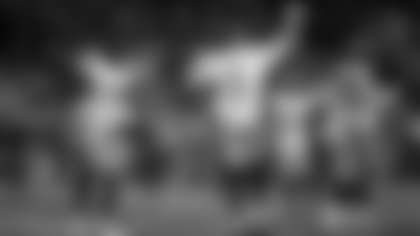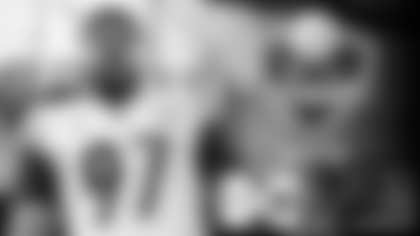"It was a spectacle so bizarre, so beyond the realm of common sense and ordinary imagination that it might have been the creation of some mad comic production – a cross between Mel Brooks and the Marquis de Sade."
--William Oscar Johnson in Sports Illustrated
What came to a crescendo in July 1977 began on Sept. 13, 1976 in a small room in the Steelers offices at Three Rivers Stadium. There, Chuck Noll was brought for his regular weekly press conference, and it was there that he would come to utter one of the most well-known phrases in NFL history.
The day before, Noll had watched his team give up 24 points in the fourth quarter to blow the game the 1976 season opener, 31-28, and if that wasn't bad enough, the loss had been at the hands of arch-nemesis Oakland. Immediately after the loss, Noll's postgame remarks began as gracious toward the victorious Raiders until the subject of George Atkinson's hit on Lynn Swann was broached.
The play in question was a third-and-5 from the Oakland 44-yard line with 1:24 left in the first half. Terry Bradshaw dumped the ball to Franco Harris down the left sideline. Swann was coming across the field from the right side and almost stopped at the 30-yard line as Harris was running down the far sideline. Atkinson came up from behind and slugged Swann in the back of the head with his forearm.
Former Cowboys quarterback Don Meredith was doing the color commentary for NBC's broadcast of the game, and he said on the air as the replay was shown: "I'm telling you, they're picking on Lynn. I don't think you're supposed to do that. I think Atkinson did another no-no – gave him a karate chop across the back of the neck."
Noll's postgame ire first was pointed at the league office: "There was a lot of discussion about putting a rule in against it this year. It wasn't done and the reason given was that, although it was illegal, no special rule was needed. There should've been a rule against slapping receivers years ago. Maybe they're waiting for somebody to get killed."
Then Noll turned it toward the Raiders: "They went after Swann again. People that sick shouldn't be allowed to play this game. Watching something like that clouds the hell out of what their offense did. It seems to come only from their defensive unit. Maybe that's a reflection on their coaching."
The day after, at the most notorious weekly press conference of his 23-seasons with the Steelers, Noll's quotes went to the next level. According to a Pittsburgh Press account of the news conference: "Noll was in no mood for subtlety, citing the blows as being applied 'with the intent to maim and not with football in mind. People like that should be kicked out of the game, or out of football … There is a certain criminal element in every aspect of society. Apparently, we have it in the NFL, too.'"
The reporters there that day instantly realized this was powerful stuff, and so they pressed forward. Noll then offered this after more questions: "What I could see was that Swann had his back turned and somebody hit him in the back of the head and neck. That's why we have officials. That's why we have a league office."
Then, when reminded that the Steelers also have been accused of dirty play, Noll answered, "We usually hit people straight on, nose-to-nose. There's nothing wrong with hard-hitting football, but not when your back is turned. It's something that has to be straightened out. I don't think that's football … We play football. We don't want to get involved with criminal actions."
The next day, when the Raiders were asked by reporters for a response to Noll's comments, Atkinson said, "It was nothing intentional. The game is a contact sport. It might be different if we had flags in our pockets. I get knocked around; I've had concussions. I don't complain about it. I don't even think it was that severe a hit. The hit I gave him last year was worse."
In the following days, Commissioner Pete Rozelle got involved, and two from each team were fined: Atkinson ($1,500) and Jack Tatum ($750 for a different incident in the game) from the Raiders, and Noll ($1,500) and Ernie Holmes ($200 for a different incident) for the Steelers.
After he got news of his fine, Atkinson said, "This may be defamation of character," and then on Dec. 6, 1976, Atkinson filed a $3 million slander and libel lawsuit against Noll, the Steelers and the Oakland Tribune, whose columnist, Ed Levitt, had written in September 1976 that Atkinson "could've killed Swann instead of giving him a concussion. He could be facing a murder rap."
It would come to be known in sports circles as the "criminal element trial."
* * *
In football, all of the players wear numbered jerseys so fans can identify them. There were players in this courtroom competition as well, but they wore suits without numbers. Still, it didn't take long for them to become recognizable to the fans of this bizarre competition.
Atkinson's attorney was Willie Brown, then an assemblyman from San Francisco who spoke at the 1972 Democratic National Convention and who had been instrumental in helping New Jersey get casino gambling. In the two years prior to this trial, Brown had defended Atkinson against charges of embezzlement, larceny and theft in the cashing of $3,000 worth of bank securities. Later in life, Brown would be elected Mayor of San Francisco.
The man heading up the Steelers' defense team was James MacInnes, who had been the first choice of the Hearst family to represent Patty Hearst in that famous trial.
The case was heard before U.S. District Court Judge Samuel Conti, a no-nonsense jurist whose first ruling on this lawsuit was that Atkinson only could seek compensatory damages, not punitive damages. During the jury selection process that began on July 11, Conti warned the pool that the trial could take two-to-three weeks, instead of the assumed couple of days.
The jury ultimately consisted of five women and one man, whose collective football knowledge was so limited that even rudimentary terms such as linebacker had to be explained to them in detail.
Noll was the first witness, and since he had been called by Atkinson's lawyers, Conti allowed him to be treated as hostile. Dan Mason handled the direct examination of Noll, and some of the exchanges were entertaining.
Mason: "Is there anybody else who constitutes 'Noll's criminals?'"
Noll: "The criminal element is made up of people who break the rules wantonly. I'd have to go back and review the films and find who fits into that category."
Mason: "Come up with another name, other than Atkinson."
Noll: "There have been people who played against us – Tatum."
Mason had turned the courtroom into a de facto coach's office, complete with a 16mm film projector and reels of game films. As Mason continued to press Noll to name names, and the film projector whirred back-and-forth, back-and-forth, Noll grudgingly agreed that incidents shown on the screen involving Glen Edwards, Joe Greene and Mel Blount were the type of willful and wanton acts Noll spoke out against. Mason: "Shall I add those names to your list?"
Noll: "That's not my list. That's your list."
Mason focused on a play involving Blount hitting Raiders receiver Cliff Branch in the head with a forearm. Noll said, "I think what Blount did was not right or correct. He was talked to after the game. We don't want that thing to happen. It was an act we do not approve of."
After Noll made similar critiques of plays involving Edwards and Greene, Mason said, "Let's add them to the list."
Noll: "Go ahead. You have the chalk."
Mason then turned to what Noll had said to draw the $1,500 fine from Rozelle: "Wasn't that a willful and wanton violation of the rules of the NFL constitution."
Noll: "It was. Go put my name on your list."
Eventually, during his nine hours on the witness stand, Noll was able to make the point that what he said – the criminal element – was only in reference to violating football rules. Noll made the point that if he had meant to say Atkinson was a societal criminal, he would have said "thrown in jail" instead of saying "kicked out of the game."
But just because Noll was excused as a witness didn't mean he was finished with all of the aggravation. On July 15, Mel Blount told reporters he was suing Noll for $5 million in compensatory damages plus $1 million in punitive damages for being included in the "criminal element." Blount seethed: "There's no chance at all that I'll play for the Steelers under Noll."
When contacted by reporters about his name being included on the list, Joe Greene refused to throw gasoline on the fire. "I feel sorry for Chuck. He's paying a high price for his success. He doesn't want to be in San Francisco testifying in some courtroom. He wants to be in training camp where he belongs. From here on, I'll be inclined to think that the Oakland Raiders are using it as a wedge to turn us against Chuck. I'd rather settle any Raiders-Steelers differences on the football field, but then again, I'm pretty old-fashioned. I don't think football matters belong in a courtroom."
The case went to the jury on July 22, and deliberations began at 9:30 a.m. Just after lunch that day, the jury sent Judge Conti a message asking again for the definition of "actual malice." Conti's reply was that Noll's statements had to "lower Atkinson in the estimation of the community, or to deter third persons from associating or dealing with him" in order to be defamation.
Since Atkinson had been signing autographs throughout the trial, his chances to win weren't good, and four hours after getting the case the jury came back in favor of Noll and the Steelers. Then almost impossibly, the rhetoric rose to a whole other level.
"The vindication of Chuck Noll and the Steelers is a very good thing for football," said James MacInnes, the Steelers' attorney. "It will put a stop to the kind of thing for which he criticized George Atkinson. As for George Atkinson, for whom we have nothing but good wishes, the verdict may be an indication of how he should play, and it may in the end make him a better and more glorious player."
Responded Atkinson attorney Willie Brown, "The jury has substantially sanctioned Chuck Noll's right to use that term against anyone he deems it appropriate to do so. They should be ashamed of themselves. I don't understand how any citizens could sit back and let someone say someone is a criminal element without doing something about it."
Dan Rooney's reaction was different but fitting for a man whose family had been committed to that point to furthering the best interests of the National Football League for over 40 years. "I'm pleased. It has been the most depressing experience of my life, but I'm happy."
Mel Blount eventually dropped his suit against Chuck Noll and reported to the team after missing 56 days of camp, but as William Oscar Johnson wrote in Sports Illustrated, there really were no winners in this sordid affair.
Well, maybe there was one winner. As MacInnes said after the verdict, "My grandson is the only person in the world with a football that has Lynn Swann's autograph on one side and George Atkinson's autograph on the other."





